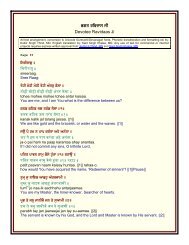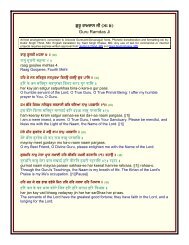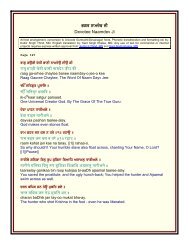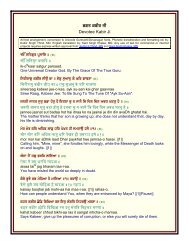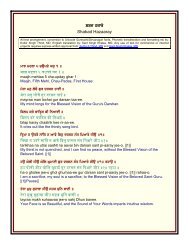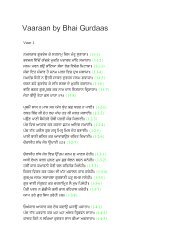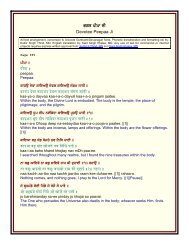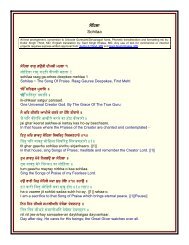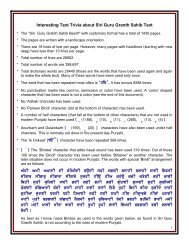Useful fonts manual - gurbanifile - Gurbanifiles.org
Useful fonts manual - gurbanifile - Gurbanifiles.org
Useful fonts manual - gurbanifile - Gurbanifiles.org
Create successful ePaper yourself
Turn your PDF publications into a flip-book with our unique Google optimized e-Paper software.
13<br />
since most of the people are used to this keyboard, this has become a standard for the<br />
computers as well. “Function Keys” & the “Numeric Key Pad” have been added to the<br />
typewriter keyboard to make it suitable for the computers. Attempts by many in the<br />
industry to introduce the most efficient keyboard called “DWARK” have not been<br />
successful. We are therefore left with an inefficient English keyboard as the standard.<br />
It is assumed that most users wishing to write Punjabi (& Hindi) will use the same<br />
keyboard for English as well as for Gurmukhi writing. Thus they are not expected to put<br />
Punjabi/Hindi labels on the keys. This requires that the Key Mapping for the<br />
Gurmukhi/Hindi be such that it is easier to remember the key map. It is true that<br />
frequent users can memorize any key map.<br />
Computers do not behave as typewriters. A typewriter is a dumb mechanical machine<br />
that types shapes on the paper in the sequence that we type in. For computers each<br />
character has a meaning far beyond a simple shape. For example all the number<br />
characters have numerical values attached to those. Similarly, during the “Spell Check”<br />
and “Search & Replace” procedures some characters are not considered as part of the<br />
words such as: . , ; : < > ( )[ ] { } - _ = + ! # % $ *. Computers actually do not associate<br />
such values to the “characters shapes” but to the “character’s number value” in the<br />
scheme as adopted by a given type of computer system. Thus, for example, if a<br />
character looks like a number but is not located on the appropriate number key it will not<br />
have the expected numerical value.<br />
A regular computer font can have up to 224 working characters (plus 32 control<br />
characters), but only 94 of these can be allotted upper & lower case positions on the<br />
keyboard. The newer Unicode <strong>fonts</strong> can have up 64000 (approx) characters each.<br />
Standard English alphabet characters are only 26 (plus 26 capitol characters). However,<br />
many more characters & symbols are used in actual writing of English. That is why<br />
many of the standard English <strong>fonts</strong> like Times & Helvetica have maximum characters<br />
each. However, the characters (as shapes) available in excess of upper & lower case in<br />
the MS Windows & Macintosh environments are not the same in similar <strong>fonts</strong>. This<br />
poses very serious problems so far as file conversions from one computer to the other<br />
are concerned. Making it more difficult is the fact that MS Windows & Macintosh<br />
environments have adopted different character numbering schemes (yes, computers<br />
remember every thing by numbers). However, the characters available as upper &<br />
lower case on the keyboard are the same in both the environments. Those characters<br />
that are in excess of upper & lower case on the keyboard are typed in different ways on<br />
Macintosh verses IBM compatible (Windows) computers.<br />
Consequently, there are many important issues that need to be considered<br />
simultaneously in deciding key mapping. One requirement often poses conflict with the<br />
other. Thus perfection is difficult to achieve. It is the balancing act that one has to<br />
consider.<br />
The following criteria have been given the utmost importance for key mapping:<br />
All rights are reserved by the author, Kulbir S Thind, MD, 3724 Hacienda Street, San Mateo, CA 94403, USA.



